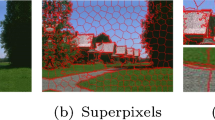Abstract
Texture segmentation aims at dividing an image into perceptually uniform regions each containing a distinct texture. In images of natural scene, texture in a region can change gradually in scale and orientation due to perspective distortion. A naive segmentation method may erroneously group image patches with the same texture but slowly varying scales and orientations into distinct regions. This paper describes a novel segmentation method which takes into account the rate of change of texture scale and orientation. The method extracts scale and orientation information from the outputs of a set of Gabor filters, and use them to group image patches into perceptually uniform texture regions.
This research is supported by NUS Academic Research Grant RP950656 and NUS Research Scholarship HD950345.
Preview
Unable to display preview. Download preview PDF.
Similar content being viewed by others
References
J. Bigün and J. M. H. du Buf. N-folded symmetries by complex moments in Gabor space and their application to unspervised texture segmentation. IEEE Transactions on Pattern Analysis and Machine Intelligence, 16(1):80–87, 1994.
A. C. Bovik, M. Clark, and W. S. Geisler. Multichannel texture analysis using localized spatial filters. IEEE Transactions on Pattern Analysis and Machine Intelligence, 12(1):55–73, 1990.
D. F. Dunn, W. E. Higgins, and J. Wakeley. Texture segmentation using 2-D Gabor elementary functions. IEEE Transactions on Pattern Analysis and Machine Intelligence, 16(2):130–149, 1994.
J. M. Francos, A. Zvi Meiri, and B. Porat. A unified texture model based on a 2-D Wold like decomposition. IEEE Transactions on Signal Processing, pages 2665–2678, Aug. 1993.
G. E. Hinton, J. L. McClelland, and D. E. Rumelhart. Distributed representation. In David E. Rumelhart and James L. McClelland, editors, Parallel Distributed Processing. MIT Press, Cambridge, Massachusetts, 1986.
A. K. Jain and F. Farrokhnia. Unsupervised texture segmentation using Gabor filters. Pattern Recognition, 24(12):1167–1186, 1991.
F. Liu and R. W. Picard. Periodicity, directionality, and randomness: Wold features for image modeling and retrieval. IEEE Transactions on Pattern Analysis and Machine Intelligence, 18(7):722–733, 1996.
S. V. R. Madiraju, T. M. Caelli, and C. C. Liu. On the covariance technique for robust and rotation invariant texture processing. In ACCV'93 Asian Conference on Computer Vision, pages 171–174, 1993.
S. V. R. Madiraju and C.-C. Liu. Rotation invariant texture classification using covariance. In Proceedings of International Conference on Image Processing, volume 2, pages 655–659, 1994.
D. K. Panjwani and G. Healey. Markov random field models for unsupervised segmentation of texture color images. IEEE Transactions on Pattern Analysis and Machine Intelligence, 17(10):939–954, 1995.
Author information
Authors and Affiliations
Editor information
Rights and permissions
Copyright information
© 1997 Springer-Verlag Berlin Heidelberg
About this paper
Cite this paper
Zhang, N., Leow, W.K. (1997). Perceptually consistent segmentation of texture using multiple channel filter. In: Chin, R., Pong, TC. (eds) Computer Vision — ACCV'98. ACCV 1998. Lecture Notes in Computer Science, vol 1352. Springer, Berlin, Heidelberg. https://doi.org/10.1007/3-540-63931-4_193
Download citation
DOI: https://doi.org/10.1007/3-540-63931-4_193
Published:
Publisher Name: Springer, Berlin, Heidelberg
Print ISBN: 978-3-540-63931-2
Online ISBN: 978-3-540-69670-4
eBook Packages: Springer Book Archive




